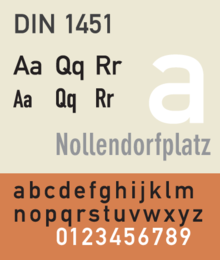DIN 1451: Difference between revisions
83.23.131.171 (talk) No edit summary |
Markus Kuhn (talk | contribs) proposing merge direction |
||
| Line 1: | Line 1: | ||
{{ |
{{mergefrom|DIN (typeface)|date=January 2009}} |
||
{{Infobox font |
{{Infobox font |
||
Revision as of 19:51, 26 January 2009
 | |
| Category | Sans-serif |
|---|---|
| Foundry | Linotype GmbH, Font Shop International |
DIN 1451 is a realist sans-serif typeface that has been defined by the German standards body Deutsches Institut für Normung since 1936. It is a widely used standard typeface for traffic, administration and business applications. In particular, DIN 1451 is the typeface commonly used on road and railway signage in Germany and a number of other countries. It was also used for many years on German car number plates, until it was replaced there in November 2000 by FE-Schrift, a font especially designed for number plates that is optimized for better tamper resistance and easier automatic character recognition.
The DIN 1451 typeface is very legible and easy to reproduce. Both a medium and a narrow version are defined today; an older broad version is no longer used but may still be encountered on some very old road signs in Germany. The typeface has gained popularity due to its wide exposure and has been also used by non-governmental organisations and businesses. For graphic design and desktop publishing, FontShop offers an extended version of this typeface called FF DIN.
The origins of this typeface go back to the "IV 44" type sheet defined by the Prussian rail network in 1906 for use on its trains. A number of glyphs have changed since then, in particular "t", "6" and "9".
The article series "The history of the design of a contemporary typeface" provides more information about the origins of the typeface.
Usage examples


Corporate branding
- Logotype and corporate typeface of Sapient corporation
- Logo of the video game Half-Life, with the "A" supplanted by the lower case lambda symbol
- Early 2000s on-screen branding of Channel 4 (British television station)
- An adapted version, Habitat DIN, is used by Habitat (retailer)
- Corporate branding of The New West End Company (the Business Improvement District company for London's West End)
- Belgian VRT news service (De Redactie) for logo and news broadcasts.
- Plone logo
- Dutch website DigitaalMedia.nl for logo and the news broadcasts.
- Primary font used in Simon Fraser University documents
- Font for Nine News for their title
See also
References
- DIN 1451-2: Schriften – Serifenlose Linear-Antiqua – Verkehrsschrift. Deutsches Institut für Normung, 1986-02.
